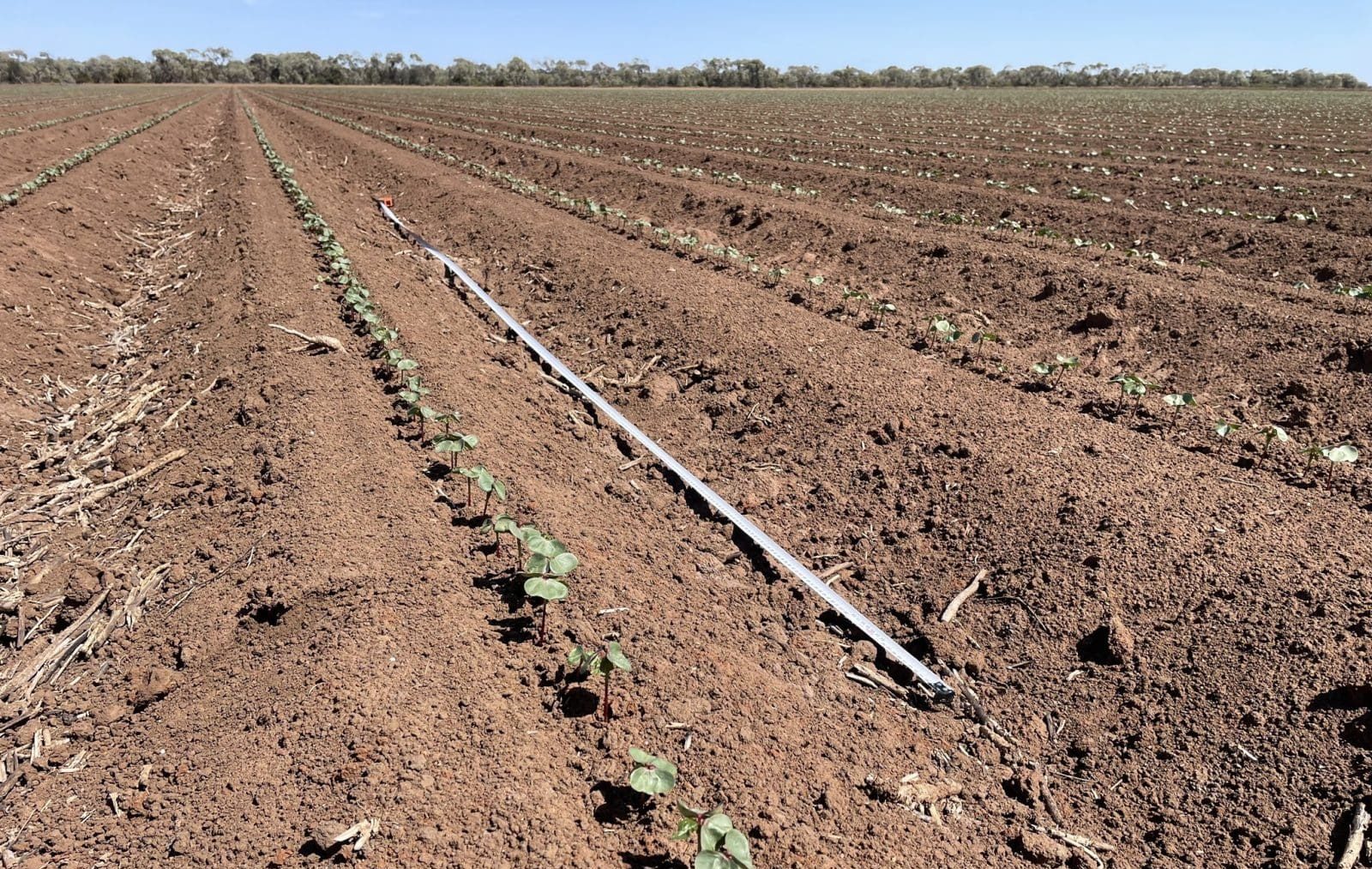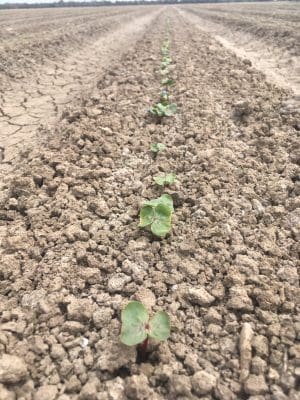
A southern NSW cotton crop off to a great start. Photo: Summit Ag
DUE to full water allocations, warm weather spells and strong prices, cotton continues to dominate as the primary summer crop in southern New South Wales.
However, patches of unexpected cold weather have seen widespread replanting as the ideal window closes at the end of the month.
Maize and niche corn varieties have emerged as another popular crop for the region, with plantings up approximately 20 percent.
It is estimated that about 75,000ha of cotton will be planted in the Murray, Murrumbidgee and Lachlan Valleys.
Mixed bag for plantings
Nutrien southern NSW cotton lead agronomist Jorian Millyard, Hay, said the health of the crop was heavily dependent on when the grower chose to plant.
He said a higher proportion of growers took the opportunity to plant in early September.
“Some are coming through okay, and some had to be replanted because of the cold weather and the rain,” Mr Millyard said.
“Some held off until after the rain that came through after the long weekend, and those crops are looking good and bouncing out of the ground.
“It’s a mixed bag out there, where some crops are two to three leaf and going along quite nicely.
“However, if you planted on that first week of October, you received around 17 cold-shock days…which really hasn’t been conducive to a good plant.”
Also based at Hay, Elders agronomist Liam Whitbourne said a proportion of cotton planted in late September and into October would need to be replanted.
“We are probably going to see 20pc replanted across our valley,” Mr Whitbourne said.
“Since the October 1 we have had non-ideal conditions which has been cool weather and a bit of rain that affected things as well.”
North-east of Hay, Cotton Grower Services Hillston’s Hugh Mackey said growers in district who planted early fared better than those in the neighbouring region.
“In early September there was a hot spell; anyone who planted then would have the best cotton in the district,” Mr Mackey said.
“At that point, there was probably 10pc of the district planted, and everybody has planted since then in very cold weather.

Cotton plants emerging from the soil. Photo: Pat McGuiness
“People are 95pc planted now as a district, most of those have germinated now…and most of them are not happy.”
He said in a typical season the germination percentage was about 70pc for the southern region, but this year it was sitting at about 50pc.
Mr Mackey said this had prompted an increase in planting.
High yields for some
For the growers who were able to plant in ideal conditions, they could expect high yields and good fibre quality.
“We are potentially heading into a higher yield potential and also better fibre quality compared to last year,” Mr Millyard said.
He said this was because the crop was “15 days ahead on flowering compared to last year”.
“We are a bit on the earlier side, so predicted first flower will be around Christmas to the first week of January.
“Last year it was anywhere from the middle to the end of January.”
Confidence down
Despite strong cotton prices and inexpensive water, confidence was down for some cotton growers impacted by flooding and cold temperatures last season.
Mr Whitbourne said about 50pc of growers in his region were forced to plant in November last year, which “really impacted yields”.
“They had to plant late because we had flooding in October, and we couldn’t traffic anything.
“It definitely taught people not to plant in November.
“People are pulling up their plantings now.”
Maize benefits
Mr Millyard said some growers turned to maize as an alternative to cotton this season.
He said other growers who needed to replant pivoted to maize as the tight ideal cotton window closed.
“I have growers down here who refuse to plant cotton because they got burnt last year and are going back to maize.
“There is a little bit of confidence that needs to be built back in.
“I think there is about a 20pc increase in maize planting this year, it has been pretty big.”
Mr Whitbourne said growers were choosing maize for its capacity to grow in tougher conditions.
“It is a good option for diseased country, or fields that might be late or fields that have some concerns for cotton.
“Maize will thrive in it; it is a pretty bullet-proof crop.”
HSR Seeds director John Auer said maize would never overtake cotton, but was a good option for growers who wanted an alternative.
“Cotton gets a priority on all irrigated grounds all the way down to Jerilderie and Deniliquin,” Mr Auer said.
“We have cheap water, so a lot of guys who may not have grown a summer crop in the past…might decide to get back into it and chose maize.”
Dairy drives interest
Mr Auer said he has seen an uptick in maize growing in northern Victoria, where the climate was too cold to grow cotton.
He said a “rock solid” dairy industry was also contributing to larger maize areas this season.
“Dairy is expanding quite rapidly into northern Victoria…and a lot of them will grow maize silage and will buy maize grain.”
Mr Auer also noted that “a few hundred hectares” extra of popcorn crop was also being planted this year.
“There is increased demand with cinemas opening after COVID, and there is a bit of an increase in export markets.
“The total popcorn crop is small, so an uptick is not a huge area.”
Get our free news straight to your inbox – Click here

HAVE YOUR SAY